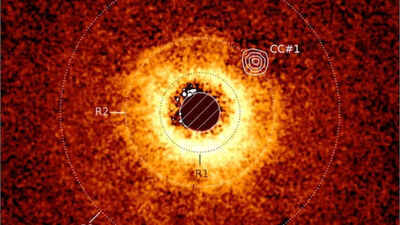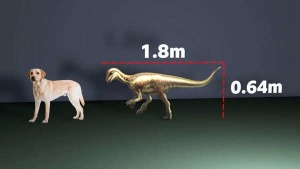The James Webb Space Telescope (JWST) has achieved a monumental milestone by directly imaging a newly discovered planet, TWA 7b. This marks the first new planet discovery for the telescope after three years of aiding astronomers in the study of exoplanets. This young world is the lowest-mass planet ever directly imaged outside our solar system.

An artist's rendering of the exoplanet TWA 7b orbiting its host star.
TWA 7b boasts an estimated mass of a mere 0.3 times that of Jupiter, approximately 100 times the mass of Earth. Significantly, it is ten times lighter than any previously directly imaged exoplanet.
This newly discovered exoplanet, TWA 7b, orbits CE Antliae (or TWA 7), a young, low-mass star roughly 111 light-years away in the constellation Antlia. CE Antliae, identified in 1999, belongs to the TW Hydrae Association, a youthful group of stars. At an estimated 6.4 million years old, CE Antliae is a cosmic infant compared to our 4.6-billion-year-old Sun. Its youth and nearly pole-on orientation from Earth make it an ideal target for JWST imaging.
The discovery of TWA 7b hinged on infrared imaging, a specialty of JWST. Young, low-mass planets emit thermal radiation in the infrared spectrum. JWST's Mid-Infrared Instrument (MIRI) and its coronagraph were crucial in this discovery.
A coronagraph blocks the overwhelming light of a star, enabling the detection of faint nearby objects like exoplanets. Utilizing high-contrast imaging techniques, the JWST team identified a faint infrared source within the debris disc surrounding TWA 7.
This source resides in a gap between dust rings, a region theorized to be shaped by a planet's gravitational influence. Simulations confirmed that a Saturn-mass planet in that location could account for the observed structure.
The disc around TWA 7 consists of three distinct rings separated by gaps. One of these gaps features a narrow ring flanked by dust-free regions, a hallmark of a planet's gravitational forces. The infrared glow detected by JWST aligns perfectly with this ring gap. Its brightness, temperature (around 320 Kelvin or 47°C), and orbital distance (approximately 50 astronomical units from the star) match expectations for a planet in this region.
The discovery of TWA 7b is a significant event in exoplanet science for several reasons:
Astronomers believe that debris disc structures around young stars provide blueprints for planetary formation. These rings and gaps indicate zones where material accumulates to form planets or is cleared by their gravity. TWA 7b may be the first direct evidence of this process in action.
Researchers used advanced image subtraction methods to detect TWA 7b. By removing residual starlight, they could isolate the planet from Solar System bodies and background galaxies. This illustrates how new observing methods and instruments on JWST, such as the coronagraph and MIRI, are enhancing our ability to discover previously inaccessible exoplanets. JWST's mid-infrared sensitivity allows it to detect planets as massive and cold as Saturn, a significant improvement in direct imaging capabilities.
JWST's ability to suppress starlight and detect the faint heat signatures of small, cold planets is opening new avenues in exoplanet discovery. Astronomers are optimistic that even lighter planets, possibly Neptune-mass or even super-Earths, could soon be within reach.
Future follow-up observations will focus on:
Newer articles
 Hetmyer's Heroics: Orcas Stun MI New York with Last-Ball Six in Record-Breaking MLC Chase
Hetmyer's Heroics: Orcas Stun MI New York with Last-Ball Six in Record-Breaking MLC Chase
 Android Users Face Critical Security Risks: Update Your Devices Now, Warns Government Agency
Android Users Face Critical Security Risks: Update Your Devices Now, Warns Government Agency
 Greg Chappell Hails Rishabh Pant's "Revolutionary" Batting, Likens Him to Gilchrist
Greg Chappell Hails Rishabh Pant's "Revolutionary" Batting, Likens Him to Gilchrist
 Dog-Sized Dinosaur Fossil Unearths New Insights into Prehistoric Life Alongside Giants
Dog-Sized Dinosaur Fossil Unearths New Insights into Prehistoric Life Alongside Giants
 West Indies Captain Chase Slams Umpiring After Test Loss, Demands Accountability
West Indies Captain Chase Slams Umpiring After Test Loss, Demands Accountability
 IRCTC's AI Chatbot, AskDisha 2.0, Streamlines Train Ticket Booking, Refunds & Information
IRCTC's AI Chatbot, AskDisha 2.0, Streamlines Train Ticket Booking, Refunds & Information
 Freestyle Chess India Event Scrapped Due to Sponsorship Issues; Carlsen Absence Confirmed
Freestyle Chess India Event Scrapped Due to Sponsorship Issues; Carlsen Absence Confirmed
 New Zealand Cricket Announces Packed 2025-26 Home Schedule Featuring Australia, England, West Indies & South Africa
New Zealand Cricket Announces Packed 2025-26 Home Schedule Featuring Australia, England, West Indies & South Africa
 Moto G54 Gets Significant Price Drop in India: Check Out the New Affordable Price Tag
Moto G54 Gets Significant Price Drop in India: Check Out the New Affordable Price Tag
 Converting JPG to PDF: A Comprehensive Guide for Preserving Image Quality and Ensuring Accessibility
Converting JPG to PDF: A Comprehensive Guide for Preserving Image Quality and Ensuring Accessibility